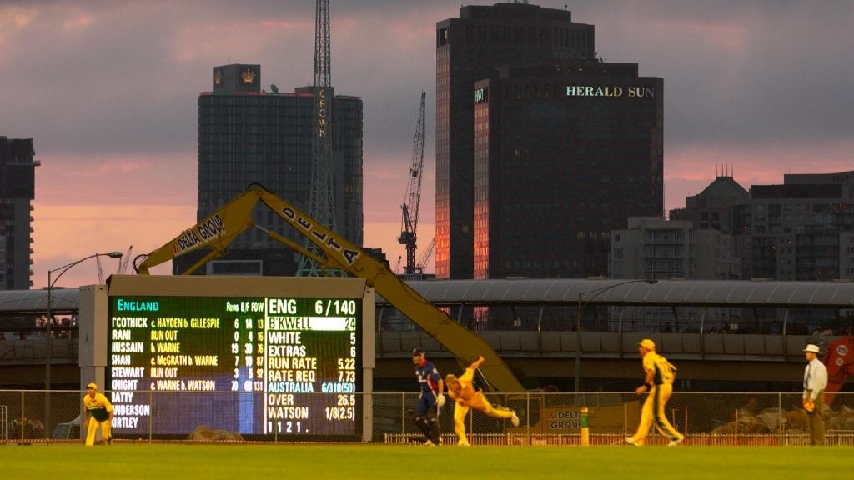- Wed, March 16, 2022

Loading

Loading

Evolution and Revolution are the part and parcel of any growth process. Cricket is not an exception. ODI evolved from a test format but T20 was a revolutionary spark.
The recent past reveals that the little rebellion, T-20 has been outsmarting its siblings. 'Test' with its genuine cricket lovers, new test championship strategy, twists and twirls throughout the game can survive brilliantly. But many people already feel that the ODI's condition is critical. Usman Khwaja recently said that "ODI will meet a slow death"..... Is it true that the days of One-day cricket are counted?
Let us travel back to the tracks of history and go ahead from there!
ODI - It has an emotional bonding with the 80s and 90s kids. They grew up watching the Asian nations dominating the Superpowers by punching above their heights to lift the world cups in that period. New televisions, coloured jerseys, day and night matches, and darshan of white balls in the ICC tournaments all excited them equally. From the Sharjah Storm to Sanath Jayasuriya's form, it provided content to talk about all day. Triangular and quadrangular series added spices to the game. Cricketers were their heroes and bubble gums were purchased just to own a cricket card. Cricket, especially the ODI format is the first love for many.
How did it all start? The birth of the ODI was not planned. 1971 is etched in cricket history as it was the year when the first ODI match was played between Australia and England as compensation after rain whitewashed the hopes to play the test match. The spectacular response from the fans to watch it raised the curtains of it, even though some of the classical cricket fans could not accept it as real cricket. But slowly the scenario changed. The World Cup took the game to the next level and along with that "WORLD SERIES CRICKET - A cricket league of that time" had enhanced and uplifted the game. Since then, 50 years have rolled by and the format keeps evolving still.
If T20 rushes like the F1 race, the Test format tests its tactics like a chess player. Compared to its younger and older siblings, ODI is the most artistic form. Attacking from the first ball is not its cup of tea. Taking time to settle down, reading the pitch, building the partnership, running between the wickets and rotating the strike to eat the dot balls, constructing the middle overs and accelerating at the end of it are all on its agenda. If you can hold your wicket, the ODI platform always gives you a chance to correct your earlier mistakes and learn on the field too. Batsmen's strike rates hit below 90 to explain the quality of the bowlers and it was always a healthy battle of bat and ball. That was the reason why India's attack against Sri Lanka in the 1999 world cup is still remembered. 300+ scores were happening only once in a blue moon.
But in the last two decades, some of the changes brought by the ICC swallowed the soul of the game. Pointing out the difficulty in using the white ball in the day and night matches as it fades away, using different balls from both ends rule was introduced. ICC said that it might help the fast bowlers because it can swing more. But that did not happen. Reverse swing is an art performed with the old ball and Wasim Akram was the master of it. Even today, the outstanding spells of him and other bowlers filled with reverse swing are a treat to watch and they troubled batsmen a lot with it. But, two new balls ruled out reverse swing from the option. This neither helps the pace bowler nor the spinner. But this worked out differently to benefit the batsmen actually to score runs easily.

Along with it, flat pitches with small boundaries aid the batsmen. The beauty of any game is unpredictability. But in ODI, pitches spoil the sport. If it aids the bowler, the targets will be less, and if it is a flat pitch, bowlers will have an off day. So it always travels in the predicted path. This is not true with Test or T20, as an inning, even an over and a ball can change the game upside down.
Another main reason for this format to lose its fame is T20 cricket. After being instilled with the overdose of T20s, modern cricket fans expect every ball to reach the boundary line. The maiden overs are considered to be a sin. Even if the bowler bowls an extraordinary over, that frustrates the fans of this sort. They are not patient enough to watch the entire match which is monotonous. Recently, former Indian cricketer, Ajay Jadeja said, "Why should someone wait for 7-8 hours in ODI, if the result of a match can be known in 4 hours in T20?!". This is the exact mentality of many cricket fans. Ex-cricketers and cricket experts are also expressing the need to revamp this format.
Even the players had lost interest in playing ODI. If the workload across all the formats can't be managed, just like Ben Stokes, most of the other cricketers also will decide to leave ODI but not T20 or Test. From the year 2002 to 2012, 1442 ODIs were played but from 2012 to 2022, only 1115 ODIs were played. This stat proves not just the fans and players, but even the boards are losing interest to conduct it.
So, what will be the future of ODI?! Well, the game may go through a tough phase now, but that doesn't mean that it is going towards the end. It may face some renovations but will be back to the form because even the test was once considered to be a finished story but that did not happen. ICC recently announced the next FTP cycle, 2023 - 2027 and said more ODI will be played during that time. Maybe we can expect more changes in the format, after the upcoming 50 over world cup.
Ideas are already pouring in. Few fans are asking to reduce the overs to 40, like the Pro 40 league in England. Some people asked to get back this new ball rule. Giving unlimited overs option to a bowler also may help. The skill and potential of all-rounders are very much tested in ODI and T20. So this may help the bowling team if one of its bowlers is having a dull day. Once Tendulkar suggested going for four innings show, to have 25 overs each. Rohit Sharma recently said, "Triangular series must be back to make it more interesting". Even that can help to a great extent.
From all these proposals, ICC must decide about the changes that have to be made to save it. After all, we need variation not just in bowling but in cricket format too.
At the end of the day, "Fittest will survive" and adaptability is the first step towards it.
Let us see how ODI will strive in this fight for life and come back stronger!!!
Comments:
Leave a Reply